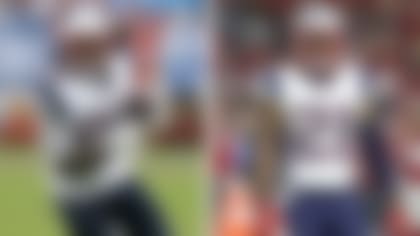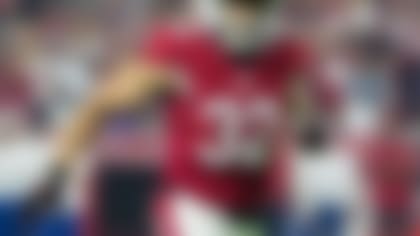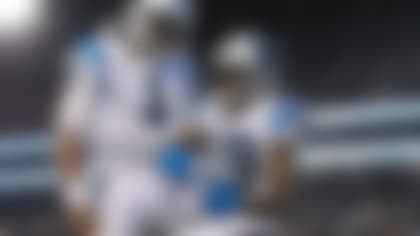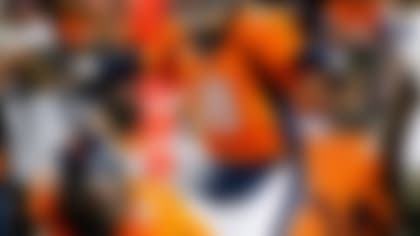Jay Cutler is ballin'!
That was my immediate reaction after poring over the 10th-year pro's numbers during the Chicago Bears' recent hot streak. From Week 4 on, Cutler has compiled a 98.7 passer rating on the strength of a touchdown-to-interception ratio of 11:3. Most impressively, he's surprisingly sparked the Bears back into playoff contention with his stellar play.
I took some time to dig into the All-22 Coaches Film to see the secrets behind his success. Here are three reasons to explain why Cutler is playing his best ball in 2015:
1) Jay Cutler is learning how to play "winning football" under John Fox.
Of all the metrics used to evaluate quarterbacks, the only one that matters to the defensive-minded coach is winning percentage. Fox, who was a longtime defensive assistant before becoming a head coach, isn't consumed with style points or gaudy statistics. When I worked for the Carolina Panthers from 2003 to 2007, I watched Fox lead the team to a pair of NFC Championship Games and an appearance in Super Bowl XXXVIII with Jake Delhomme at quarterback, largely due to his ability to win in an unorthodox but conservative fashion. Fox later guided the Denver Broncos into the playoffs behind a red-hot Tim Tebow and an option offense that rarely featured a forward pass. And he went on to win big with Peyton Manning directing a "pitch-and-catch" aerial attack by trusting the veteran's management skills and low-risk approach.
From a philosophical standpoint, Fox believes turnovers are the biggest deciding factor in games, and he stresses ball security to his quarterbacks at every turn. He frequently tells his offensive players that every drive should end in a kick (PAT, field goal or punt), to emphasize the importance of not giving the ball away. Thus, he would implore quarterbacks to make sound decisions from the pocket -- if the smartest play, based on the reaction of the defense, is to throw the ball away, that's what he would encourage them to do.
In Cutler, Fox inherited a talented gunslinger with a 61-58 record, including a 44-38 mark with the Bears, heading into 2015. Despite his impressive physical tools and A-plus arm talent, Cutler had been plagued by turnover woes throughout his career. He's tossed 135 interceptions in 127 career games, including five picks this season. When you consider his 79 fumbles (33 lost), the Bears' signal caller looks like a bit of a turnover machine in the pocket.
That's why I'm impressed with how Cutler is playing under Fox's direction. He has drastically reduced his attempted "hero" throws (forced passes into traffic) and shown better management skills on early downs. The veteran patiently dumps the ball off to his running backs and tight ends when the defense takes away his primary receiver, leading to manageable distances (5 yards or fewer) on third down. He's posted a passer rating of 85.0 or better in seven straight games, and he's avoided throwing multiple picks in nine straight contests. Yes, the low-risk passing game -- featuring an assortment of "layups" (bubbles, flash screens and quick routes) on early downs -- installed by the Bears has helped, but Cutler deserves credit for buying into the conservative approach.
Cutler is evolving. He's posted a 95.3 passer rating -- which, if it holds, will mark a career best -- while helping the Bears get to 4-5. It's clear Fox's impact on the gunslinger could help the "Monsters of the Midway" make an unexpected playoff run.
2) Adam Gase has built the Bears' offense around Cutler's strengths.
The biggest challenge facing NFL offensive coordinators is crafting a system that accentuates the strengths of the quarterback's game. While most play callers readily acknowledge the importance of putting the quarterback in the best position to succeed, few are able to evaluate their signal callers and incorporate concepts that fit his skills and enhance the talents of the supporting cast.
I've come away from the All-22 Coaches Film of the Bears' recent contests believing offensive coordinator Adam Gase has constructed a system that accentuates Cutler's dynamic game and helps the team's perimeter playmakers get the ball within their sweet spots on the field. The delicate balance between the two missions is rarely discussed, but masterful play designers are able to accomplish the feat to maximize the explosive potential of the offense.
In Cutler, Gase has an electric playmaker with exceptional physical tools. He is not only capable of making every throw in the book from the pocket, but he is a pinpoint passer on the move. Although Cutler's mechanics and footwork are far from textbook, he displays rare arm talent and an ultra-quick release. Thus, Cutler is able to attack the field vertically (via deep shots) or horizontally (via quick routes) without issue.
From a play-design standpoint, Cutler's skills allow the Bears to use a variety of "now" concepts (quick screens to wide receivers and running backs) designed to get the ball into the hands of their explosive players. Chicago also features an assortment of quick slants and speed outs from spread and condensed formations that exploit the underneath areas of coverage. With Cutler adept at getting the ball out of his hands, the Bears are able to generate big plays on low-risk throws on the perimeter.
In the play below, from Chicago's Week 10 win over the St. Louis Rams, the Bears are aligned in a tight ace formation, with tight ends Martellus Bennett and Zach Miller positioned off the ball. The Bears are executing a "stick" concept on each side, with Bennett and Miller running to the flat and the outside receivers running stick routes. Cutler sees a favorable matchup to his left and quickly fires the ball out to Miller on the flat route when the defender fails to expand immediately after the snap. The big-bodied tight end makes the catch, breaks a tackle and rumbles for an 87-yard score on a simple "pitch-and-catch" concept (TO VIEW THE PLAY, SCROLL LEFT TO RIGHT ON THE IMAGE BELOW):
The Bears have been rolling with these simple concepts in recent weeks, leading to an improved completion percentage and passer rating from Cutler over the past six games. Consider that in his first two games of the season, Cutler completed 57.8 percent of his passes, with two touchdowns and two picks and a passer rating of 78.5. From Week 4 on, he's completed 65.5 percent of his passes with 11 touchdowns and three picks, and a passer rating of 98.7.
While the Bears have attacked opponents with a heavy dose of quick game, Gase has continued to sprinkle in enough deep shots to keep defenders from squatting on routes. Most importantly, the incorporation of the vertical passing game has allowed the team to take advantage of Cutler's exceptional arm strength to produce big plays. Though this approach was attempted by the Bears' previous offensive coordinators during Cutler's tenure, Gase has extensively featured fade or go-routes down the boundary to generate big plays. By directing most of Cutler's vertical throws along the sideline, the Bears have drastically reduced the odds of a turnover, as there are typically fewer defenders in the area (most fade throws occur against man-to-man or single coverage) due to the sideline.
Additionally, the fade and go-route down the boundary allow Cutler to throw up a "50-50" ball in Alshon Jeffery's direction in key situations. Given the fourth-year pro's superior size (6-foot-3, 216 pounds) and leaping ability, the alley-oop toss is a smart play in most circumstances.
In the Bears' Week 9 win over the San Diego Chargers, they repeatedly attacked the deep sideline on an assortment of fade and go-routes. In the play below, Jeffery is positioned on the right as the "X" receiver on the back side of an ace trey formation, and he'll run a go-route against bump-and-run coverage at the line. Jeffery wins with an inside move on Jason Verrett, then slips back to the outside to get along the boundary. The move gives Cutler enough space to fit a tightrope throw down the sideline. Jeffery snags the ball for a 47-yard gain (TO VIEW THE PLAY, SCROLL LEFT TO RIGHT ON THE IMAGE BELOW):
Gase has also taken advantage of Cutler's underrated athleticism by featuring an assortment of movement-based passes designed to get him on the perimeter. With bootleg passes simplifying the read for Cutler, the concepts are another easy way to get the veteran into a groove. Additionally, the Bears are using variations of the zone-read to enhance the movement-based passing game.
In the play below, from that Week 9 win over the Chargers, the Bears use the movement passing game to get Cutler an easy completion on the perimeter. Chicago breaks the huddle in a trey bunch formation to the right, with Bennett positioned as the WR3. Cutler executes a play fake (outside zone right) before rolling to his left to pass. Bennett slides behind the line and leaks into the flat to the left. With the Chargers' OLB (Melvin Ingram) fooled by the run action, Cutler is able to throw an easy toss to Bennett, resulting in a 12-yard gain (TO VIEW THE PLAY, SCROLL LEFT TO RIGHT ON THE IMAGE BELOW):
With the Bears using a multi-dimensional passing game that features a number of "layups" for the ultra-talented passer, the veteran is enjoying one of the best seasons of his career and pushing the Chicago back into playoff contention with his stellar play from the pocket.
3) The Bears' commitment to the run has alleviated pressure on Cutler.
Having a strong running game is one of the easiest ways to alleviate the burden on the quarterback to carry an offensive attack. A dynamic running game not only allows an offense to control the clock through a patient, "grind it out" approach, but it sets up big-play opportunities through an assortment of run-action passes. Despite having a perennial Pro Bowl RB (Matt Forte) in the lineup for years, the Bears seemingly refused to adopt a run-heavy philosophy to help Cutler enjoy favorable passing downs against loaded fronts with one-on-one coverage on the perimeter. The abandonment of the running game exposed the Bears' leaky offensive line, with the veteran taking a beating at the hands of pass rushers attacking from all angles as a result.
With Fox at the helm, the Bears have gotten back to relying on a run-heavy attack to set the offensive tone. They rank 14th in rushing offense (114.6 rush yards) with Forte and Jeremy Langford paving the way. Although the production and rushing yards are certainly important, the increased rushing attempts (29.4 per game, up from 22.2 in 2014) from the Bears are forcing defensive coordinators to prepare for a more diversified attack. Thus, they are unable to throw out a host of blitzes designed to strictly knock Cutler off his spot in the pocket.
Studying the All-22 Coaches Film, I expected to see the Bears running the normal inside and outside zone concepts that are featured in most NFL offenses. Additionally, I thought I would see a few powers and counter plays to attack the defense between the tackles. However, I was shocked to see Chicago utilizing a handful of zone-read concepts, with Cutler executing option reads at the point of attack. Though Cutler was a standout safety and return specialist as a high school player, few expect him to use his legs to complement the Bears' rushing attack.
Yet, that's exactly what the Bears are having him do. In the play below, from last week's win over the Rams, Cutler perfectly executes the zone-read for a big gain on the perimeter. The Bears are aligned in a trix formation, with Langford positioned as the halfback. Cutler takes the snap, sticks the ball into Langford's belly, then reads the reaction of the defensive end. When the defender steps down with the run action, Cutler keeps the ball and races around the end. With the Bears also adding a bubble screen element to the concept, Cutler continues to read the reaction of the slot defender before deciding to keep the ball on the perimeter. This results in a 26-yard gain for the Bears(TO VIEW THE PLAY, SCROLL LEFT TO RIGHT ON THE IMAGE BELOW):
Of course, the zone-read keeper is merely meant to distract defenders who would otherwise collapse on Forte and Langford, but it is also a prime example of how the Bears are creatively using the running game to alleviate some of the pressure on Cutler as a playmaker. If the Bears continue to get solid contributions from the ground game, NFC opponents could have a tougher time slowing down the spectacular playmaker down the stretch.
Follow Bucky Brooks on Twitter @BuckyBrooks.












